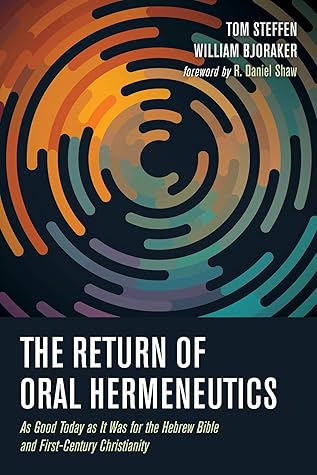Kindle Notes & Highlights
by
Tom Steffen
Read between
June 11 - July 27, 2020
Paul Koehler
Narrative rationality is its logic. The essential components of this logic are the following. Human communication is tested against the principles of probability (coherence) and fidelity (truthfulness and reliability). Probability, whether a story ‘hangs together,’ is assessed in three ways: by its argumentative or structural coherence; by its material coherence, that is, by comparing and contrasting stories told in other discourses (a story may be internally consistent, but important facts may be omitted, counterarguments ignored, and relevant issues overlooked); and by characterological
...more
305 How did the widow of the deceased prophet
Figure 4.2. From Oral Hermeneutics to Creative-Correct Theology
Fisher.
fruit” (James 5:17 ESV).
first relive the unfolding of the story. Then, and only then, can they fully appreciate the characterization development of
God/spirits focused: 1.Who experienced God’s faithfulness? 2.Who experienced God’s power? 3.Who experienced God’s loyalty? 4.Who experienced God’s justice? 5.How did God purify ______?
How did God protect ______? 7.What promise did God make to ______? 8.How does God challenge ______? 9.How did God bless/curse ______? 10.How did God react to ______’s choice to ______? 11.Who’s the chief challenger of God in the story? 12.Who challenged God’s authority? 13.Who is the honored hero/heroine/Divine Hero of the story?
Remember some of the spiritual observations we saw in the story last week?
It was assumed that there are gods over every territory and those gods only had power over their own territory—your god is operative in your territory; our god is operative in ours.
Okay, let’s pray first—Father
As you read below, imagine the storyteller standing and orally telling the story, and how his/her body language—eye behavior, facial expression, voice tone, emotions—might be appropriate to the plotline and character dialogue. Take note of the pauses in the speech and the affect they might have on the impact and meaning of the story.
What is the point of tension
STORYTELLER: I’m wondering how important that honor was to him?
VALERIE: Can you define honor and shame? STORYTELLER: Sure. Honor and shame are
It is a relationship that evokes loyalty, allegiance, love, and deference.
STORYTELLER: Yes. And then there is this: But his officers tried to reason with him and said, “Father, if the prophet had told you to do something very difficult and heroic, wouldn’t you have done it? So you should certainly obey him when he says simply, ‘Go and wash and be cured!’” So Naaman went down to the Jordan River and dipped himself seven times, as Elisha had instructed him. And his skin became as healthy as the skin of a young child, and he was cleansed and healed!
STORYTELLER: I am impressed with how he is persuaded by his servants here, to reconsider following this humiliating command. What insights might we gain here into the character of Naaman?
STORYTELLER: And Naaman had other choices at this pivotal juncture, right? How else could he have chosen to act?
thing: I am my master the king’s first officer. When my master the king goes into the temple of his god Rimmon to worship there and he leans on my arm, may the Lord pardon me when I too must bow.” “Go in shalom,” Elisha said. So Naaman started home again.
ABE: Seems odd, almost superstitious to us that he wanted some of the dirt from the land of Israel to take home. But you said in the introduction to the story that this was the belief of the “territorial gods.” If he is going to worship the God of Israel, he needs some of the land of Israel to worship him from. Build an altar to the Lord on the soil of Israel. STORYTELLER: Yes. Does Elisha deny this request?
And finally, stated so memorably by missionary martyr Jim Eliot, killed in Ecuador in 1956, fulfilling his own restatement of the Christian paradox, “He is no fool who gives what he cannot keep, to gain what he cannot


